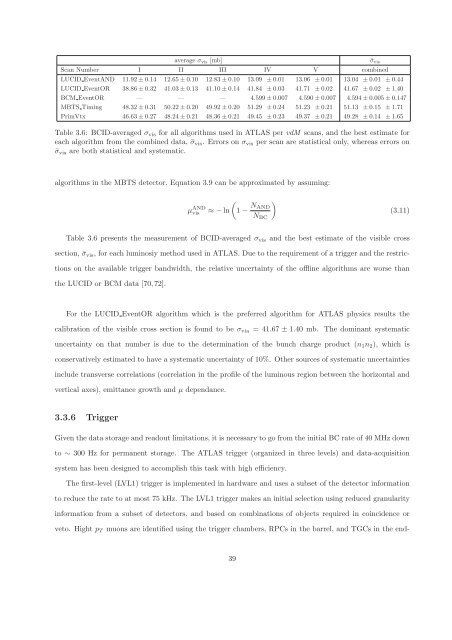CERN-THESIS-2012-153 26/07/2012 - CERN Document Server
CERN-THESIS-2012-153 26/07/2012 - CERN Document Server
CERN-THESIS-2012-153 26/07/2012 - CERN Document Server
Create successful ePaper yourself
Turn your PDF publications into a flip-book with our unique Google optimized e-Paper software.
average σvis [mb] ¯σvis<br />
Scan Number I II III IV V combined<br />
LUCID EventAND 11.92 ± 0.14 12.65 ± 0.10 12.83 ± 0.10 13.09 ± 0.01 13.06 ± 0.01 13.04 ± 0.01 ± 0.44<br />
LUCID EventOR 38.86 ± 0.32 41.03 ± 0.13 41.10 ± 0.14 41.84 ± 0.03 41.71 ± 0.02 41.67 ± 0.02 ± 1.40<br />
BCM EventOR — — — 4.599 ± 0.0<strong>07</strong> 4.590 ± 0.0<strong>07</strong> 4.594 ± 0.005 ± 0.147<br />
MBTS Timing 48.32 ± 0.31 50.22 ± 0.20 49.92 ± 0.20 51.29 ± 0.24 51.23 ± 0.21 51.13 ± 0.15 ± 1.71<br />
PrimVtx 46.63 ± 0.27 48.24 ± 0.21 48.36 ± 0.21 49.45 ± 0.23 49.37 ± 0.21 49.28 ± 0.14 ± 1.65<br />
Table 3.6: BCID-averaged σvis for all algorithms used in ATLAS per vdM scans, and the best estimate for<br />
each algorithm from the combined data, ¯σvis. Errors on σvis per scan are statistical only, whereas errors on<br />
¯σvis are both statistical and systematic.<br />
algorithms in the MBTS detector, Equation 3.9 can be approximated by assuming:<br />
µ AND<br />
<br />
vis ≈ −ln 1 − NAND<br />
<br />
NBC<br />
(3.11)<br />
Table 3.6 presents the measurement of BCID-averaged σvis and the best estimate of the visible cross<br />
section, ¯σvis, for each luminosiy method used in ATLAS. Due to the requirement of a trigger and the restric-<br />
tions on the available trigger bandwidth, the relative uncertainty of the offline algorithms are worse than<br />
the LUCID or BCM data [70,72].<br />
For the LUCID EventOR algorithm which is the preferred algorithm for ATLAS physics results the<br />
calibration of the visible cross section is found to be σvia = 41.67 ± 1.40 mb. The dominant systematic<br />
uncertainty on that number is due to the determination of the bunch charge product (n1n2), which is<br />
conservatively estimated to have a systematic uncertainty of 10%. Other sources of systematic uncertainties<br />
include transverse correlations (correlation in the profile of the luminous region between the horizontal and<br />
vertical axes), emittance growth and µ dependance.<br />
3.3.6 Trigger<br />
Given the data storage and readout limitations, it is necessary to go from the initial BC rate of 40 MHz down<br />
to ∼ 300 Hz for permanent storage. The ATLAS trigger (organized in three levels) and data-acquisition<br />
system has been designed to accomplish this task with high efficiency.<br />
The first-level (LVL1) trigger is implemented in hardware and uses a subset of the detector information<br />
to reduce the rate to at most 75 kHz. The LVL1 trigger makes an initial selection using reduced granularity<br />
information from a subset of detectors, and based on combinations of objects required in coincidence or<br />
veto. Hight pT muons are identified using the trigger chambers, RPCs in the barrel, and TGCs in the end-<br />
39















